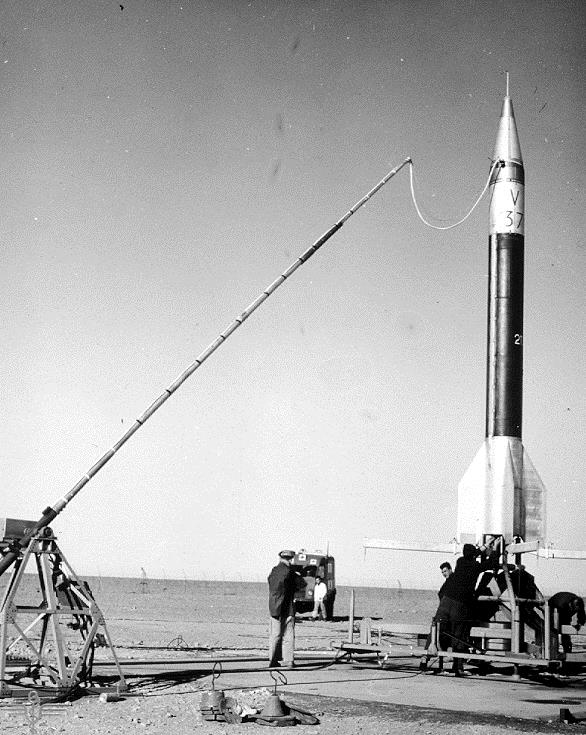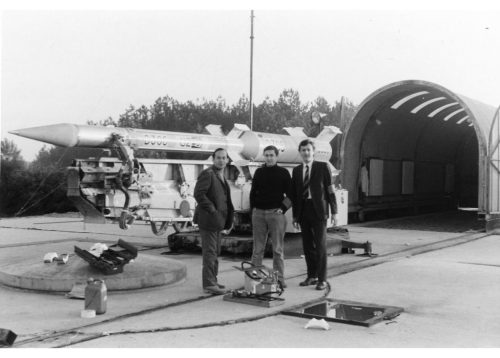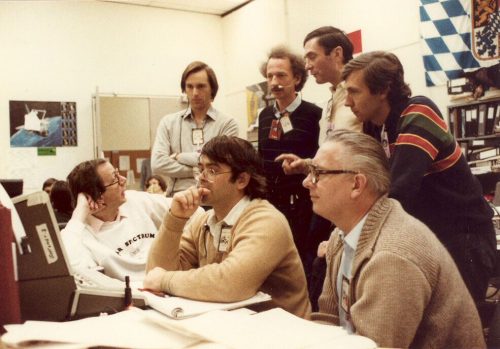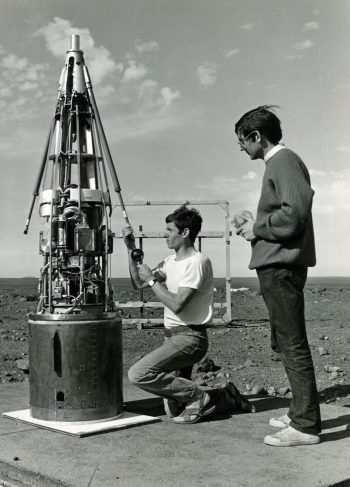


At the end of the war, the PTT (Posts, Telegraphs and Telephones) founded the CNET (National Center for the Study of Telecommunications) which, in association with the CNRS and the IPG, gave André Lebeau (who has notably since directed Météo -France and CNES), the opportunity to found the GRI (Ionospheric Research Group) which in 1974 would become the CRPE (Research Center in Physics of the Terrestrial and Planetary Environment) then the CETP (Centre for Terrestrial and Planetary Environments) ) before partly joining LATMOS. Indeed, it is through successive reflections on the ionosphere (above 150 km altitude) and on the ground that TSF waves can circle the Earth and thus enable communication over very long distances. But the interest in this region quickly goes beyond the scope of telecommunications technology and will be the start of a vast research program on the exploration of this unknown region where the satellites around our planet operate today.
At the same time, a student of Alfred Kastler, Jacques Blamont, recruited several brilliant young researchers including Claude Cohen-Tannoudji, and founded the Aeronomy Service in 1956 (a laboratory which as a whole joined LATMOS) to launch into the study of the photochemistry of the upper atmosphere by using the Véronique rockets in Hammaguir.

At the end of the war, the PTT (Posts, Telegraphs and Telephones) founded the CNET (National Center for the Study of Telecommunications) which, in association with the CNRS and the IPG, gave André Lebeau (who has notably since directed Météo -France and CNES), the opportunity to found the GRI (Ionospheric Research Group) which in 1974 would become the CRPE (Research Center in Physics of the Terrestrial and Planetary Environment) then the CETP (Centre for Terrestrial and Planetary Environments) ) before partly joining LATMOS. Indeed, it is through successive reflections on the ionosphere (above 150 km altitude) and on the ground that TSF waves can circle the Earth and thus enable communication over very long distances. But the interest in this region quickly goes beyond the scope of telecommunications technology and will be the start of a vast research program on the exploration of this unknown region where the satellites around our planet operate today.
At the same time, a student of Alfred Kastler, Jacques Blamont, recruited several brilliant young researchers including Claude Cohen-Tannoudji, and founded the Aeronomy Service in 1956 (a laboratory which as a whole joined LATMOS) to launch into the study of the photochemistry of the upper atmosphere by using the Véronique rockets in Hammaguir.
Under the aegis of the Space Research Committee, during the late 1950s, France was provided with new budgets by the government. These beginnings of the French space program, to which the SA and GRI teams contributed to providing the first scientific objectives, led in 1961 to the development of the first Diamant rocket launcher (3rd after those of the United States and the Soviet Republic). , which in 1965 would succeed in putting the first French satellite Asterix into orbit.
The year 1962 was marked by an ambitious scientific program:
Under the aegis of the Space Research Committee, during the late 1950s, France was provided with new budgets by the government. These beginnings of the French space program, to which the SA and GRI teams contributed to providing the first scientific objectives, led in 1961 to the development of the first Diamant rocket launcher (3rd after those of the United States and the Soviet Republic). , which in 1965 would succeed in putting the first French satellite Asterix into orbit.
The year 1962 was marked by an ambitious scientific program:

In 1965, the second FR-1 satellite developed jointly by CNET and CNES aimed to study the propagation of very low frequency waves in the ionosphere, measuring for the first time the Earth’s magnetic field at around 750 km. Then the CRPE will assume responsibility for the Franco-Soviet Roseau satellite project, the first satellite with an on-board computer, unfortunately abandoned in 1968.
The structure and variations of the magnetic field are crucial to understanding the ionosphere. In 1977, as part of a NASA-ESA collaboration, the pair
of satellites ISEE A and B were launched to explore the interactions between the solar wind and the Earth’s magnetosphere.
The SA and GRI actively participate in almost all of these programs. If the various French programs are based on scientific projects, it is the Space Research Committee and then the CNES, which instigate, direct and finance these studies. Indeed, unlike other countries, space research in France is organized around the CNES but on a model originally proposed by Jacques Blamont where researchers from French laboratories propose experiments to the CNES Scientific Programs Committee. If they are selected and financeable, these experiments are placed under the responsibility of a CNES project manager and a scientist from a joint university-CNRS laboratory who can build the payload (case for the exploration of the system solar) or contribute to the specifications to be given to manufacturers or/and take responsibility for the processing algorithms (the case rather chosen for Earth observation). If all researchers can propose ideas, in practice only around ten French laboratories are leaders in space instruments. The demonstration of technological maturity involves the creation of prototypes operating on the ground, or on board an airplane or balloon. Today, instruments are often integrated into missions which are carried out in collaboration between several French laboratories or with other space agencies.


The geographical position of the Kerguelen Archipelago on the line of force of the magnetic field also gives researchers a particular field of experimentation. Following on from the first balloon launches in 1962, the Earth’s space environment is once again probed by balloons and rockets. Then in 1966, the Dumont D’Urville base, on Adélie land practically at the South Magnetic Pole, offered scientists a privileged position for studies of the magnetosphere and sun-earth relations. Rocket surveys continue and will make it possible to study the envelope of rarefied neutral and ionized gases surrounding the globe from an altitude of 100 km.
The structure and variations of the magnetic field are crucial to understanding the ionosphere. In 1977, as part of a NASA-ESA collaboration, the pair
of satellites ISEE A and B were launched to explore the interactions between the solar wind and the Earth’s magnetosphere.
The first campaign was organized at the request of the Ionospheric Research Group. The study focuses on the ionosphere, particularly rich in charged particles in the vicinity of the Magnetic Pole, and the exchanges and distributions of particles.

These rockets will also make it possible to study for the first time the solar spectrum in the ultraviolet region not visible from the surface. The study of the intense solar emission of Lyman alpha (1963) by the Aeronomy Service makes it a real French specialty. These studies continue with the OGO-5 satellite (1969) leading to the discovery of the heliopause, the continuity of which is still ensured today by the SWAN instrument on board SOHO developed by the Aeronomy Service and which is still functioning for 20 years. The sun would continue to be characterized subsequently with Solspec on board the international station then with a microsatellite entirely developed at the Picard Aeronomy Service, making it possible to better characterize its weak variations and perhaps better understand their impacts on the climate.

In 1967 the use of French rockets for scientific investigations stopped for our laboratories in 1967, leaving the launcher division to perfect itself in a European dynamic to give birth to the series of Ariane launchers used today. In 1966 the Franco-Soviet space cooperation agreement made it possible to continue a major collaborative program on the island of Heyss until 1976, using Soviet sounding rockets for various experiments such as, for example, profile measurements of electronic density and temperature and electric fields. The latter is an important parameter and yet difficult to measure. The particles and droplets of water induce electrical currents through friction, the reality of which can be clearly seen during discharges such as lightning, sprites and bluejets.

Following in the footsteps of the French pioneers of balloon flights and for the needs of meteorology, in 1958, the brand new Aeronomy Department of the CNRS took the initiative of using balloons for scientific research purposes. This enterprise, initially carried out under the responsibility of the CNRS, was then continued by the CNES. Alongside CNES, scientists are developing and launching 3000m3 balloons inflated with hydrogen from Trappes, then in Kerguelen to study auroral X-rays simultaneously at two conjugated magnetic points; the other point being the University of Minneapolis. Then it was Aire-sur-l’Adour carrying in 1965, 124 kg at almost 40km altitude. Then it was the over-pressurized balloons (1967), from which the technique of isentropic balloons resulted in 1973, leading to the Infra-Red hot air balloon which, made up of 2 materials for its 2 hemispheres respectively upper and lower, would allow by capturing the Infra-Red radiation from long-duration flights necessary for the exploration of the stratosphere, a region discovered 50 years previously in Trappes by a compatriot Leon Tesserec de Bort. This technique would prove very useful for understanding the mechanisms leading to the ozone hole. The balloons would also make it possible to study the auroral ionosphere during periods of magnetic storms as part of the SAMBO program (1974). But also prove to be a unique tool for measuring and better understanding fluctuations due to atmospheric dynamics at different scales. The Aeronomy Department will also develop specific balloons composed of a toroidal envelope and a floating external envelope capable of very well following the air mass and therefore small-scale fluctuations such as turbulence and gravity waves.

The study of the upper atmosphere saw, in the mid-1960s, the development of an ionospheric incoherent scatter sounder, operating from the ground which led to the European incoherent scatter sounder project EISCAT (1980) today. now in service in the polar zone and other techniques such as the meteor radar technique.
The radar technique will then be used for numerous applications, particularly in the 95 GHz range, to study the dynamic, microphysical and radiative properties of weakly precipitating tropospheric clouds for the study of clouds and precipitation, and it will be embarked on aircraft. then into space.
The French rocket program will strongly concern the 2 laboratories which today constitute LATMOS by studying the ionic composition, its coupling with the magnetic field and the photochemistry of the lower thermosphere. Several hundred rockets were therefore used for scientific purposes.

In 1965 thanks to the appearance of the laser, the Aeronomy Service in 1965 perfected its surveys of the sodium layer with a lidar at the Haute-Provence Observatory by resonance, then we identified on the same principle Potassium, the Lithium, Calcium then Iron. Once again, we will use this knowledge to develop wind measurements of the lower thermosphere on NASA’s largest scientific satellite from nocturnal emissions; UARS. Lidar is not abandoned but these possibilities extend to measuring the profile of ozone, temperature, wind, volcanic aerosols and subsequently to aerosols, clouds and water vapor. After having played a determining role in the establishment of an international network for ozone monitoring (NDACC) providing today the longest series of this type (30 years), this technique does not escape its spatialization. First by plane, then in space with the Russians (Alissa) and with the Americans (Calipso). Systematic measurements lead our laboratories to carry out new infrastructure projects at the Observatoire de Haute Provence then at Réunion without forgetting Antarctica where the ozone hole continues to disappear.

The study of ozone will also be marked by a technique developed at the Aeronomy Department then exploited at LATMOS through stellar occultation which allows the GOMOS experiment on board the ESA ENVISAT satellite to multiply the number of data with very good vertical resolution. This technique is used to explore the atmospheres of Venus and Mars with our partners at IKI and IASB. The use of spectra for the study of the atmosphere extends to the Infra-Red domain, which is more suitable for measuring greenhouse gases and many other species as shown by the IASI mission on the series METOP satellites.
The Franco-Soviet space cooperation agreement signed in 1966 also allowed the laboratories, which gave birth to Latmos, to embark on the exploration of planetary atmospheres. The first instruments were built and integrated into Soviet Prognoz satellites and the Venera then Vega probes towards Venus, followed by the Phobos and Mars 96 missions towards Mars. The success of these missions was not always a success but the expertise acquired around spectrometers was re-used with our American colleagues at NASA for the Voyager, Pioneer-Venus and Galileo missions. Then in a European context with SOHO, Giotto, Venus-Express and Mars express. Thanks to these data, French numerical models of these planetary atmospheres began to be developed. To complete the study
of the composition of these atmospheres, with very important questions such as atmospheric exhaust and the conditions for the appearance of life, researchers in our laboratories have developed the technique of mass spectrometry firstly on the Huygens probe then on SAM-GC on Curiosity. In order to guide these probes and the “rovers”, microwave or permitivity measurements (case of Rosetta) have made it possible to better understand the composition and foliation of the first meters of the subsoil. The use of microwave measurements also allowed the laboratory to better understand the impact of surface roughness on remote sensing measurements up to the quantification of wave height as part of the CFOSAT measurement currently being carried out with the Chinese agency.
L’accord de coopération spatiale franco-soviétique signée en 1966 a également permis aux laboratoires, qui ont donnés naissance au Latmos, de se lancer dans l’exploration des atmosphères planétaires. Des premiers instruments ont été construit et intégrés à des satellites soviétiques Prognoz et les sondes Venera puis Vega en direction de Venus puis se fut les missions Phobos et Mars 96 vers Mars. Le succès de ces missions ne fut pas toujours un succès mais l’expertise, acquise autour des spectromètres, a été ré-utilisée avec nos collègues américains de la NASA pour les missions Voyager, Pioneer-Venus et Galileo. Puis dans un cadre Européen avec SOHO, Giotto, Venus-Express et Mars express. Grace à ces données, les modèles numériques français de ces atmosphères planétaires ont commencé à être développés. Pour compléter l’étude
de la composition de ces atmosphères, avec des questions très importantes comme l’échappement atmosphériques et les conditions d’apparition de la vie, les chercheurs de nos laboratoires ont développés la technique de spectrométrie de masses tout d’abord sur la sonde Huygens puis sur SAM-GC sur Curiosity. Afin de guider, ces sondes et les « rovers », des mesures hyperfréquences ou de permitivité (cas de Rosetta) ont permis de mieux comprendre la composition et le feuilletage des premiers mètres du sous-sol. L’utilisation des mesures hyperfréquences a permis également au laboratoire de mieux comprendre l’impact de la rugosité des surfaces sur les mesures de télédétection jusqu’à la quantification de la hauteur des vagues dans le cadre de la mesure CFOSAT en cours de réalisation avec l’agence chinoise.